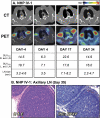Evaluation of monkeypox disease progression by molecular imaging
- PMID: 22013221
- PMCID: PMC3209815
- DOI: 10.1093/infdis/jir663
Evaluation of monkeypox disease progression by molecular imaging
Abstract
Infection of nonhuman primates (NHPs) with monkeypox virus (MPXV) is currently being developed as an animal model of variola infection in humans. We used positron emission tomography and computed tomography (PET/CT) to identify inflammatory patterns as predictors for the outcome of MPXV disease in NHPs. Two NHPs were sublethally inoculated by the intravenous (IV) or intrabronchial (IB) routes and imaged sequentially using fluorine-18 fluorodeoxyglucose ((18)FDG) uptake as a nonspecific marker of inflammation/immune activation. Inflammation was observed in the lungs of IB-infected NHPs, and bilobular involvement was associated with morbidity. Lymphadenopathy and immune activation in the axillary lymph nodes were evident in IV- and IB-infected NHPs. Interestingly, the surviving NHPs had significant (18)FDG uptake in the axillary lymph nodes at the time of MPXV challenge with no clinical signs of illness, suggesting an association between preexisting immune activation and survival. Molecular imaging identified patterns of inflammation/immune activation that may allow risk assessment of monkeypox disease.
Figures




Similar articles
-
[18F]-Fluorodeoxyglucose Uptake in Lymphoid Tissue Serves as a Predictor of Disease Outcome in the Nonhuman Primate Model of Monkeypox Virus Infection.J Virol. 2017 Oct 13;91(21):e00897-17. doi: 10.1128/JVI.00897-17. Print 2017 Nov 1. J Virol. 2017. PMID: 28814515 Free PMC article.
-
Comparative analysis of monkeypox virus infection of cynomolgus macaques by the intravenous or intrabronchial inoculation route.J Virol. 2011 Mar;85(5):2112-25. doi: 10.1128/JVI.01931-10. Epub 2010 Dec 8. J Virol. 2011. PMID: 21147922 Free PMC article.
-
Poxvirus antigen staining of immune cells as a biomarker to predict disease outcome in monkeypox and cowpox virus infection in non-human primates.PLoS One. 2013;8(4):e60533. doi: 10.1371/journal.pone.0060533. Epub 2013 Apr 5. PLoS One. 2013. PMID: 23577120 Free PMC article.
-
FDG-PET for axillary lymph node staging in primary breast cancer.Eur J Nucl Med Mol Imaging. 2004 Jun;31 Suppl 1:S97-102. doi: 10.1007/s00259-004-1531-z. Epub 2004 May 5. Eur J Nucl Med Mol Imaging. 2004. PMID: 15133635 Review.
-
Imaging axillary lymph nodes in patients with newly diagnosed breast cancer.Curr Probl Diagn Radiol. 2012 Sep-Oct;41(5):149-58. doi: 10.1067/j.cpradiol.2011.08.002. Curr Probl Diagn Radiol. 2012. PMID: 22818835 Review.
Cited by
-
Monkeypox Virus in Animals: Current Knowledge of Viral Transmission and Pathogenesis in Wild Animal Reservoirs and Captive Animal Models.Viruses. 2023 Mar 31;15(4):905. doi: 10.3390/v15040905. Viruses. 2023. PMID: 37112885 Free PMC article. Review.
-
Orthopoxvirus variola infection of Cynomys ludovicianus (North American black tailed prairie dog).Virology. 2013 Sep 1;443(2):358-62. doi: 10.1016/j.virol.2013.05.029. Epub 2013 Jun 27. Virology. 2013. PMID: 23809939 Free PMC article.
-
Nuclear Medicine in Times of COVID-19: How Radiopharmaceuticals Could Help to Fight the Current and Future Pandemics.Pharmaceutics. 2020 Dec 21;12(12):1247. doi: 10.3390/pharmaceutics12121247. Pharmaceutics. 2020. PMID: 33371500 Free PMC article. Review.
-
Factors affecting the likelihood of monkeypox's emergence and spread in the post-smallpox era.Curr Opin Virol. 2012 Jun;2(3):335-43. doi: 10.1016/j.coviro.2012.02.004. Epub 2012 Mar 6. Curr Opin Virol. 2012. PMID: 22709519 Free PMC article. Review.
-
The impact of "omic" and imaging technologies on assessing the host immune response to biodefence agents.J Immunol Res. 2014;2014:237043. doi: 10.1155/2014/237043. Epub 2014 Sep 16. J Immunol Res. 2014. PMID: 25333059 Free PMC article. Review.
References
-
- Likos AM, Sammons SA, Olson VA, et al. A tale of two clades: monkeypox viruses. J Gen Virol. 2005;86:2661–72. - PubMed
-
- Heymann DL, Szczeniowski M, Esteves K. Re-emergence of monkeypox in Africa: a review of the past six years. Br Med Bull. 1998;54:693–702. - PubMed
-
- Learned LA, Reynolds MG, Wassa DW, et al. Extended interhuman transmission of monkeypox in a hospital community in the Republic of the Congo, 2003. Am J Trop Med Hyg. 2005;73:428–34. - PubMed
-
- Parker S, Nuara A, Buller RM, Schultz DA. Human monkeypox: an emerging zoonotic disease. Future Microbiol. 2007;2:17–34. - PubMed
-
- Huhn GD, Bauer AM, Yorita K, et al. Clinical characteristics of human monkeypox, and risk factors for severe disease. Clin Infect Dis. 2005;41:1742–51. - PubMed

